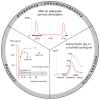Oxytocin: an emerging regulator of prolactin secretion in the female rat
- PMID: 22129099
- PMCID: PMC3288386
- DOI: 10.1111/j.1365-2826.2011.02263.x
Oxytocin: an emerging regulator of prolactin secretion in the female rat
Abstract
In the female rat, a complex interplay of both stimulatory and inhibitory hypothalamic factors controls the secretion of prolactin. Prolactin regulates a large number of physiological processes from immunity to stress. Here, we have chosen to focus on the control of prolactin secretion in the female rat in response to suckling, mating and ovarian steroids. In all three of these states, dopamine, released from neurones in the mediobasal hypothalamus, is a potent inhibitory signal regulating prolactin secretion. Early research has determined that the relief of dopaminergic tone is not sufficent to account for the full surge of prolactin secretion observed in response to the suckling stimulus, launching a search for possible prolactin-releasing factors. This research has subsequently broadened to include searching for prolactin-releasing factors controlling prolactin secretion after mating or ovarian steroids. A great deal of literature has suggested that this prolactin-releasing factor may include oxytocin. Oxytocin receptors are present on lactotrophs. These oxytocin receptors respond to exogenous oxytocin and antagonism of endogenous oxytocin inhibits lactotroph activity. In addition, the pattern of oxytocin neuronal activity and oxytocin release correlate with the release of prolactin. Here, we suggest not only that oxytocin is stimulating prolactin secretion, but also that prolactin secretion is controlled by a complex network of positive (oxytocin) and negative (dopamine) feedback loops. We discuss the available literature and attempt to describe the circuitry we believe may be responsible for controlling prolactin secretion.
© 2011 The Authors. Journal of Neuroendocrinology © 2011 Blackwell Publishing Ltd.
Figures







Similar articles
-
Reduced dopaminergic tone during lactation is permissive to the hypothalamic stimulus for suckling-induced prolactin release.J Neuroendocrinol. 2020 Nov;32(11):e12880. doi: 10.1111/jne.12880. Epub 2020 Jul 6. J Neuroendocrinol. 2020. PMID: 32627906
-
Recent studies on the role of brain peptides in control of anterior pituitary hormone secretion.Peptides. 1984;5 Suppl 1:3-7. doi: 10.1016/0196-9781(84)90259-6. Peptides. 1984. PMID: 6148738 Review.
-
Antagonist of pituitary adenylate cyclase activating polypeptide suppresses prolactin secretion without changing the activity of dopamine neurons in lactating rats.Neuroendocrinology. 2001 Jan;73(1):68-74. doi: 10.1159/000054622. Neuroendocrinology. 2001. PMID: 11174019
-
Oxytocin action at the lactotroph is required for prolactin surges in cervically stimulated ovariectomized rats.Endocrinology. 2007 Oct;148(10):4649-57. doi: 10.1210/en.2007-0646. Epub 2007 Jul 5. Endocrinology. 2007. PMID: 17615142 Free PMC article.
-
Regulation of prolactin secretion during pregnancy and lactation.Prog Brain Res. 2001;133:173-85. doi: 10.1016/s0079-6123(01)33013-3. Prog Brain Res. 2001. PMID: 11589129 Review.
Cited by
-
Social touch promotes interfemale communication via activation of parvocellular oxytocin neurons.Nat Neurosci. 2020 Sep;23(9):1125-1137. doi: 10.1038/s41593-020-0674-y. Epub 2020 Jul 27. Nat Neurosci. 2020. PMID: 32719563
-
Dopamine/Tyrosine Hydroxylase Neurons of the Hypothalamic Arcuate Nucleus Release GABA, Communicate with Dopaminergic and Other Arcuate Neurons, and Respond to Dynorphin, Met-Enkephalin, and Oxytocin.J Neurosci. 2015 Nov 11;35(45):14966-82. doi: 10.1523/JNEUROSCI.0293-15.2015. J Neurosci. 2015. PMID: 26558770 Free PMC article.
-
Working Smarter Not Harder: Oxytocin Increases Domestic Dogs' (Canis familiaris) Accuracy, but Not Attempts, on an Object Choice Task.Front Psychol. 2019 Oct 1;10:2141. doi: 10.3389/fpsyg.2019.02141. eCollection 2019. Front Psychol. 2019. PMID: 31632314 Free PMC article.
-
Oxytocin, Vasopressin and Prolactin in New Breastfeeding Mothers: Relationship to Clinical Characteristics and Infant Weight Loss.J Hum Lact. 2020 Feb;36(1):136-145. doi: 10.1177/0890334419838225. Epub 2019 Apr 29. J Hum Lact. 2020. PMID: 31033381 Free PMC article.
-
Co-shared genetics and possible risk gene pathway partially explain the comorbidity of schizophrenia, major depressive disorder, type 2 diabetes, and metabolic syndrome.Am J Med Genet B Neuropsychiatr Genet. 2019 Apr;180(3):186-203. doi: 10.1002/ajmg.b.32712. Epub 2019 Feb 6. Am J Med Genet B Neuropsychiatr Genet. 2019. PMID: 30729689 Free PMC article. Review.
References
-
- Riddle O, Bates RW, Dykshorn SW. The preparation, identification and assay of prolactin--a hormone of the anterior pituitary. Am J Physiol. 1933;105(1):191–216.
-
- Cooke NE, Coit D, Weiner RI, Baxter JD, Martial JA. Structure of cloned DNA complementary to rat prolactin messenger RNA. J Biol Chem. 1980;255(13):6502–10. - PubMed
-
- Freeman ME, Kanyicska B, Lerant A, Nagy G. Prolactin: Structure, Function, and Regulation of Secretion. Physiol Rev. 2000;80(4):1523–631. - PubMed
-
- Grosvenor CE, Whitworth N. Evidence for a steady rate of secretion of prolactin following suckling in the rat. J Dairy Sci. 1974;57(8):900–4. - PubMed
-
- Freeman ME, Smith MS, Nazian SJ, Neill JD. Ovarian and hypothalamic control of the daily surges of prolactin secretion during pseudopregnancy in the rat. Endocrinology. 1974;94(3):875–82. - PubMed
Publication types
MeSH terms
Substances
Grants and funding
LinkOut - more resources
Full Text Sources
Other Literature Sources

